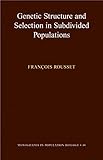Genetic structure and selection in subdivided populations /François Rousset.
Material type: TextSeries: Publication details: Princeton, New Jersey ; Oxford, England : Princeton University Press, (c)2013.Description: 1 online resource (281 pages) : illustrationsContent type:
TextSeries: Publication details: Princeton, New Jersey ; Oxford, England : Princeton University Press, (c)2013.Description: 1 online resource (281 pages) : illustrationsContent type: - text
- computer
- online resource
- 9781400847242
- QH455 .G464 2013
- COPYRIGHT NOT covered - Click this link to request copyright permission: https://lib.ciu.edu/copyright-request-form
| Item type | Current library | Collection | Call number | URL | Status | Date due | Barcode | |
|---|---|---|---|---|---|---|---|---|
 Online Book (LOGIN USING YOUR MY CIU LOGIN AND PASSWORD)
Online Book (LOGIN USING YOUR MY CIU LOGIN AND PASSWORD)
|
G. Allen Fleece Library ONLINE | Non-fiction | QH455 (Browse shelf(Opens below)) | Link to resource | Available | ocn893672775 |
Includes bibliographies and index.
Cover; Title; Contents; List of Figures and Tables; Acknowledgments; Preface; What Is and Is Not There; Assumed Background; Of Gene and Fitness; 1. Introduction; Genetic Structure in Relation to Selection; Plan of the Book; 2. Selection and Drift; Selection in Panmictic Populations; Evolution in Spatially Structured Populations; Selection and Local Drift; Effective Size in Subdivided Populations; Measuring Population Structure; Genetic Identity; Statistical Concepts of Equilibrium and Population; Summary; 3. Spatially Homogeneous Dispersal: The Island Model and Isolation by Distance.
Island ModelsIsolation by Distance; Dispersal in Natural Populations; The Lattice Models; Differentiation under Isolation by Distance; Summary; Appendix 1: General Analysis of the Lattice Model; Appendix 2: Miscellaneous Results ; Diversity in a Deme; Average Diversity in a Population; Differentiation under Low Dispersal; 4. Interpretations of Inbreeding and Relatedness Coefficients in Subdivided Populations; Probabilities of Coalescence in Migration Matrix Models; Migration Matrix Models: Formulation; Probabilities of Coalescence; Interpretations of FST; Coalescence before Dispersal.
Separation of Time ScalesAn Ancestral Reference Population?; Differences between Distributions of Coalescence Times; Properties of Inbreeding Coefficients; Sensitivity to Mutation and to Past Demographic Events; No Mutation; Alternative Measures of Allelic Divergence; 5. Evolutionary Dynamics; Fitness in a Panmictic Population; Example: Resource Competition; Convergence Stability; Evolutionary Stability; Applicability of This Framework; Fitness in a Subdivided Population; Frequency Dependence in Subdivided Populations; How to Measure Selection?; Conclusion.
Appendix: The Prisoner's Dilemma GameNoniterated Game; Iterated Game; 6. Convergence Stability in a Spatially Homogeneous Population; Weak Selection Effects on Probability of Fixation; Fixation Probability as Allele Frequency Change; Fitness Functions; Fixation Probability: Direct Fitness Expansion; Expression in Terms of Parameters of Population Structure ; Practical Computation of Convergence Stability; Island Model; Isolation by Distance; Conclusions; Direct Fitness Method; Fitness Maximization; 7. Inclusive Fitness, Cooperation, and Altruism; What Inclusive Fitness Does Measure.
Inclusive and Direct FitnessHamilton's Derivation of Inclusive Fitness; Isolation by Distance; Altruism in Spatially Subdivided Populations; Cost, Benefit, and Relatedness; Helping Neighbors; Other Examples; The Importance of Kin Competition; Kin Recognition; Implications for Modeling Approaches; Inclusive Fitness Theory; Other Frameworks; Appendix: Helping Neighbors under Isolation by Distance; 8. Diploidy (and Sex); Population Structure of Diploid Populations; Analysis of Pollen and Seed Dispersal; Joint Effects of Selfing and Selection on Population Structure.
Various approaches have been developed to evaluate the consequences of spatial structure on evolution in subdivided populations. This book is both a review and new synthesis of several of these approaches, based on the theory of spatial genetic structure. François Rousset examines Sewall Wright''s methods of analysis based on F-statistics, effective size, and diffusion approximation; coalescent arguments; William Hamilton''s inclusive fitness theory; and approaches rooted in game theory and adaptive dynamics. Setting these in a framework that reveals their common features, he demonstrates how.
COPYRIGHT NOT covered - Click this link to request copyright permission:
There are no comments on this title.
